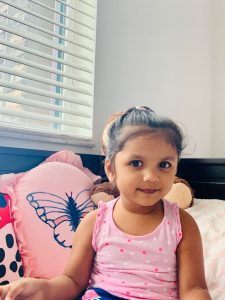Big Journey for Little Girl with LCA3
Parvi Gaddam has endured a lot for a little girl genetically diagnosed at 6 months’ old with a form of Leber congenital amaurosis called LCA3 (SPATA7).
Like most parents discovering their child has a rare inherited disease, the diagnosis of their now 3-year-old took Harini and Suresh Gaddam by surprise because no one in their families experienced vision loss or blindness. LCA, usually inherited as an autosomal recessive genetic condition, means a child inherits two copies of the mutated gene, one from each parent.
The couple, who are software engineers living in Tampa, Fla., hoped Parvi’s mutated gene would be RPE65 associated with LCA2, because vision in some patients with that mutation improves through the federally approved LUXTURNA® gene therapy.
LCA3 Diagnosis Confirmed
She underwent rounds of scans and tests, and at 6-months, Parvi and her family traveled to Pennsylvania’s University of Pittsburgh Medical Center Children’s Hospital, where doctors diagnosed her with a mutation in her SPATA7 gene, associated with LCA3, one of the 27 known forms of LCA. Rare among rare diseases, LCA3 accounts for fewer than 2 percent of all LCA cases. Early-stage research using mice models has shown promising results with gene therapy treatment.
Parvi does have some light perception. Her vision teacher comes to her home because of the COVID-19 pandemic, and helps her by reading storybooks, singing songs, and touching and seeing objects. Parvi also enjoys the company of her older brother, 8-year-old Thanmay, who returned to class in school.
“She’s very smart, does her routine, enjoys reading the books, songs, walking, and playing with her brother,” Suresh said.
Her parents follow studies on the gene and reached out to Hope in Focus and the Foundation for Fighting Blindness for help in their journey.
Harini and Suresh began raising funds for SPATA7 research through GoFundMe and through the Foundation, with a goal of $5 million.
The family is searching for more people living with the SPATA7 mutation to gather patients and bring research forward to clinical trials in humans, with the hope that a treatment or cure will come to fruition.
“We will not give up,” her father said. “And we will continue fighting for my little angel and the SPATA7/LCA3 patient group to bring this treatment to humans.”


